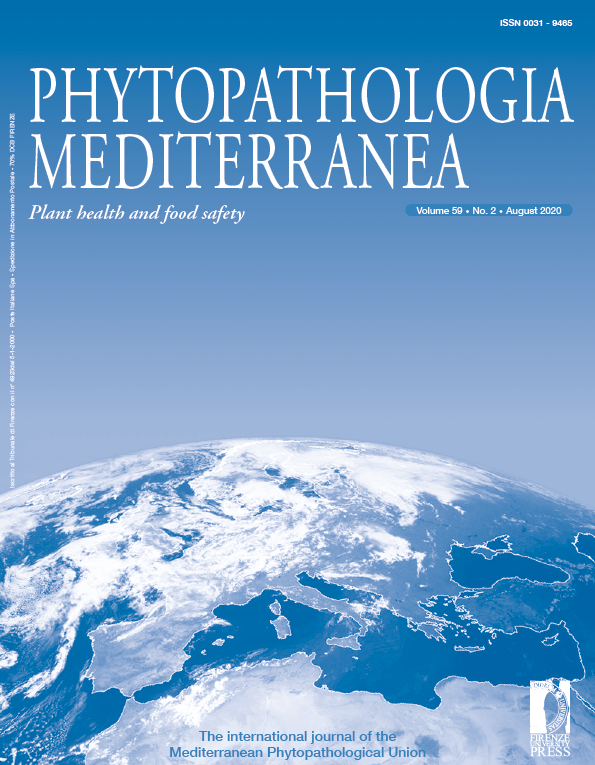Comparison of conventional and novel molecular diagnostic methods for detection of Xylella fastidiosa from insect vectors
Published 2020-07-17
Keywords
- Xylella fastidiosa, Philaenus spumarius, Neophilaenus campestris, PCR, real-time PCR, LAMP, FLOS-LAMP, detection
How to Cite
Abstract
The efficiency of three diagnostic methods, i.e. PCR, real-time PCR and LAMP, for detection of Xylella fastidiosa (Xf) genomic DNA from Philaenus spumarius (Ps) and Neophilaenus campestris (Nc) insect vectors was evaluated using three total nucleic acids (TNA) extraction methods (EM). In addition, a new real-time LAMP technology, Fluorescence of Loop Primer Upon Self Dequenching-LAMP (FLOS-LAMP), originally developed for human virus diagnoses, was optimized and assessed for detection of Xf in insect vectors. EM1 consisted of entire insects heated in an extraction buffer (EB) containing Tris-EDTA and TRITON-X100. In EM2, TNAs were extracted only from excised heads of insects, and heated again in the EB of EM1. EM3 consisted of grinding entire insects, heads and bodies recuperated from EM2, with a CTAB buffer. The molecular analyses conducted on 100 specimens of Ps and 50 of Nc, collected from a Xf-infected olive orchard (Lecce province, Italy), showed that 29% of specimens (40 Ps and four Nc) were positive to the presence of Xf. The comparison between the three methods revealed that EM3 is the most efficient for extracting Xf-genomic DNA from insect vectors, of which 44 specimens were positive for Xf in each of the diagnostic methods used, including the newly optimized FLOS-LAMP assay. In general, the real-time PCR and LAMP assays were more competent than the conventional PCR for detection of Xf in insect vectors, independently from the EM used. The newly optimized FLOS-LAMP technique had a detection limit of 1 fg μL-1 of Xf-genomic DNA, compared to the 10 fg μL-1 for conventional LAMP. The high sensitivity of the FLOS-LAMP was evident through the greater number of overall Xf-infected insect vectors detected (60%), compared to those for LAMP (45%,), real-time PCR (28%) and PCR (10%). FLOS-LAMP, being a more sensitive and specific assay, together with EM3, were the most appropriate approaches for an accurate detection of Xf in insect vectors.
Downloads
References
Bucci E.M., 2018. Xylella fastidiosa, a new plant pathogen that threatens global farming: Ecology, molecular biology, search for remedies. Biochemical and Biophysical Research Communications 502 (2): 173-182. https://doi.org/10.1016/j.bbrc.2018.05.073.
Cavalieri V., Altamura G., Fumarola G., Di Carolo M., Saponari M., Cornara D., Bosco D., Dongiovanni C., 2019. Transmission of Xylella fastidiosa subspecies pauca sequence type 53 by different insect species. Insects 10, 324. https://doi:10.3390/insects10100324.
Denancé N., Briand M., Gaborieau R., et al., 2019 Identification of genetic relationships and subspecies signatures in Xylella fastidiosa. BMC Genomics 20:239.https://doi.org/10.1186/s12864-019-5565-9.
Elbeaino T., Yaseen T., Valentini F., Ben Moussa I.E., Mazzoni V., D’Onghia A.M., 2014. Identification of three potential insect vectors of Xylella fastidiosa in southern Italy. Phytopathologia Mediterranea 53(2): 328–332.
EFSA, 2019. Pest survey card on Xylella fastidiosa. EFSA supporting publication: EN-1667: 51. https://doi:10.2903/sp.efsa.2019.EN-1667
EPPO Bulletin, 2019. Volume 49, Issue 2, PM 7/24 (4) Xylella fastidiosa https://doi.org/10.1111/epp.12575.
Gadkar V.J., Goldfarb D.M., Gantt S., et al., 2018. Real-time Detection and Monitoring of Loop Mediated Amplification (LAMP) Reaction Using Self-quenching and De-quenching Fluorogenic Probes. Scientific Reports 8: 5548. https://doi.org/10.1038/s41598-018-23930-1.
Harper S., Ward L., Clover G., 2010. Development of LAMP and real-time PCR methods for the rapid detection of Xylella fastidiosa for quarantine and field applications. Phytopathology 100(12): 1282-1288.
Hendson M., Purcell A.H., Chen D., Smart C., Guilhabert M., Kirkpatrick B., 2001. Genetic diversity of Pierce’s disease strain and other pathotypes of Xylella fastidiosa. Applied Environmental Microbiology 67:895-903.
Martelli G.P., Boscia D., Porcelli F., Saponari M., 2016. The olive quick decline syndrome in south-east Italy: a threatening phytosanitary emergency. European Journal of Plant Pathology 144: 235-243. https://doi.org/10.1007/s10658-015-0784-7.
Minsavage G.V., Thompson C.M., Hopkins D.L., Leite M.V.B.C., Stall R.E., 1994. Development of a polymerase chain reaction protocol for detection of Xylella fastidiosa in plant tissue. Phytopathology 84: 456-461.
Redak R.A., Purcell A.H., Lopes J.R.S., Blua M.J., Mizell R.F., Andersen P.C., 2014. The biology of xylem fluid-feeding insect vectors of Xylella fastidiosa and their relation to disease epidemiology. Annual Review of Entomology 49: 243-245.
Yaseen T., Drago S., Valentini F., Elbeaino T., Stampone G., Digiaro M., D’Onghia A.M., 2015. On-site detection of Xylella fastidiosa in host plants and in “spy insects” using the real-time loop-mediated isothermal amplification method. Phytopathologia Mediterranea 54(3): 488-496. https://doi.org/10.14601/Phytopathol_Mediterr-15250.






